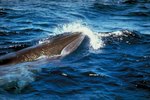
The narwhal isn't a mythical animal, but he's a source of belief in one of the most magical creatures of mythology: the unicorn. The Vikings traded the male narwhal's long, spiralled tusk, lending credence to the unicorn myth as these artifacts appeared in markets from the Mediterranean to the Far East during the Middle Ages. His scientific name Monodon monceros means "one tooth," while narwhal comes from the Old Norse and translates as "corpse whale."
Physical Characteristics
The narwhal is born gray but develops a black-and-white mottled coat as he grows. Kristin Laidre at the Polar Science Center says the "corpse whale" monicker may come from the resemblance between the narwhal's coloring and the skin color of a drowned sailor. Males are up to 16 feet in length, while females are some 13 feet. The male can weigh up to 4,000 pounds and the female is a more slender 2,200 pounds. The tusk differentiates the narwhal from other similarly shaped whales, such as the beluga. Only male narwhals have a tusk, which is 6 to 9 feet long. This tusk grows out of his lower jaw. Its doesn't appear to have any single purpose, and as scientists point out, it isn't essential to the narwhal's survival because females don't have a tusk and live longer than males. The narwhal's typical lifespan is around 50 years.
Habitat and Distribution
The narwhal habitat stretches from the Canadian High Arctic to Greenland, but occasionally some narwhals appear as far east as Svalbard Island off the coast of Norway. The Polar Science Center in Seattle estimates the narwhal population is around 80,000. This population is made up of subpopulation groups. A subpopulation group doesn't spend all year together but comes together during the summer period at the narwhals' summering grounds. Satellite tracking has identified some 10 subpopulations. Baffin and Somerset Island and northwest Greenland have the largest summering grounds, with up to 40,000 narwhals congregating there.
During winter months narwhals are the only whales that stay in the Arctic ice. The surface area of open water dwindles to 3 percent, and the narwhal depends on fissures in the ice so he can rise to the surface and breathe. Here he is vulnerable to being trapped in the ice if the cracks close due to lower temperatures.
Diet
Narwhals have no teeth for eating. They do have two teeth in the upper jaw, but these point outward rather than down inside the mouth. Because the narwhal lacks the ability to chew, he feeds on softer marine animals such as squid. Studies of narwhal stomach contents show he's also fond of turbot. The narwhal's ability to dive deep allows him to hunt for fish like the turbot, which are found at depths of between 984 to 5,250 feet. Deep-water shrimp and arctic cod are other favorite foods of this somewhat picky eater.
Communication and Reproduction
Narwhals are keen communicators. Clicks, whistles, bangs, trumpeting and a sound described as a "creaking door" feature in his repertoire of sounds. He uses echo-location to find prey, and some research suggests his "bang" sounds may disorientate his prey, making it easier to catch, although this idea needs further study according to Fisheries and Oceans Canada.
The narwhal female starts breeding at an age of 6 to 8 years. Narwhals mate in spring and give birth in summer of the following year; the gestation period is 14 months, and only one calf is born at a time. Calves usually measure around 5 feet at birth.
References
Photo Credits
-
Jupiterimages/Photos.com/Getty Images
Writer Bio
Based in London, Eleanor McKenzie has been writing lifestyle-related books and articles since 1998. Her articles have appeared in the "Palm Beach Times" and she is the author of numerous books published by Hamlyn U.K., including "Healing Reiki" and "Pilates System." She holds a Master of Arts in informational studies from London University.



